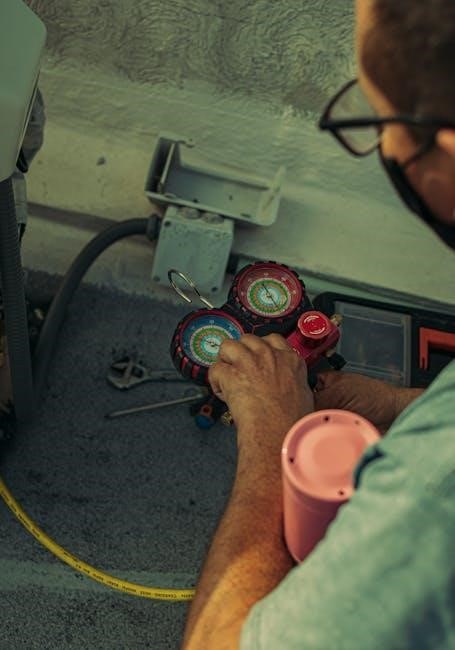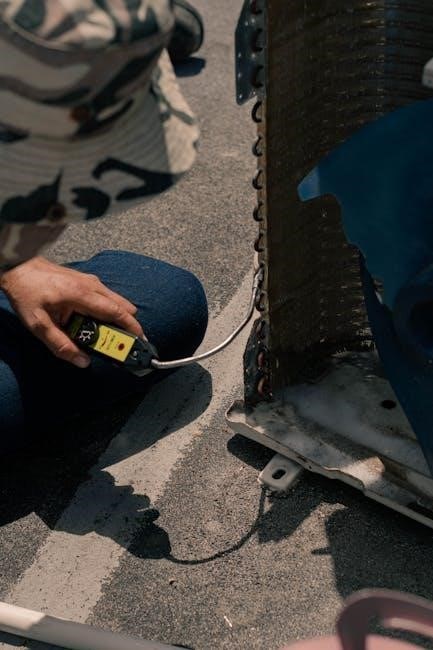
HVAC troubleshooting is essential for resolving common issues like no power, insufficient heating, or strange noises. Regular maintenance and understanding system basics can prevent costly repairs and ensure optimal performance.
Understanding the Basics of HVAC Systems
An HVAC system consists of three main components: heating, ventilation, and air conditioning. It works by regulating indoor temperature, humidity, and air quality. The heating element, often a furnace or heat pump, warms the air, while the air conditioning unit cools it. Ventilation ensures proper airflow through ducts and vents. Electrical controls, such as thermostats, manage system operation. Understanding these basics helps identify potential issues during troubleshooting. Familiarity with components like coils, compressors, and blowers is also crucial for diagnosing problems. Regular maintenance of filters and coils can prevent common issues, ensuring efficient performance and extending system lifespan. Knowing how these parts interact is key to effective troubleshooting and maintaining a comfortable home environment.
Why Regular Maintenance is Crucial

Regular maintenance is vital for ensuring the efficiency, reliability, and longevity of HVAC systems. It helps prevent unexpected breakdowns, reduces energy bills, and maintains optimal performance. During maintenance, technicians inspect and clean components like filters, coils, and fans, which can become clogged or worn. Neglecting maintenance can lead to issues such as insufficient heating or cooling, strange noises, and even system failures. Additionally, regular maintenance ensures safety by identifying potential hazards like gas leaks or electrical malfunctions. A well-maintained system also improves indoor air quality, contributing to a healthier living environment. Scheduling annual or seasonal check-ups with a professional can address minor problems before they escalate, saving time and money in the long run.

Common HVAC Issues and Solutions
Identifying and addressing issues like no power, insufficient heating, strange noises, leaks, and thermostat malfunctions is key to restoring comfort and efficiency in your home.
No Power to the HVAC System
Losing power to your HVAC system can be frustrating, but troubleshooting often starts with simple checks. First, ensure the circuit breaker hasn’t tripped or a fuse hasn’t blown. Verify that the system’s switch is in the “on” position and that all electrical connections are secure. Check the thermostat to confirm it’s set correctly and has functioning batteries if it’s a wireless model. If issues persist, inspect the wiring for damage or corrosion. While some problems may require professional attention, addressing basic electrical or thermostat-related issues can restore power quickly. Always prioritize safety by turning off the power supply before inspecting internal components. Regular maintenance can help prevent unexpected outages and ensure reliable operation year-round.
Insufficient Heating or Cooling
Insufficient heating or cooling is a common HVAC issue that can disrupt home comfort. Start by checking the thermostat settings to ensure it’s set correctly for your desired temperature. Blocked air vents or dirty filters can restrict airflow, reducing system efficiency. Verify that all vents are open and unobstructed. If the issue persists, inspect the condenser coils for dirt or debris, as this can hinder heat exchange. Low refrigerant levels or a malfunctioning compressor may also cause inadequate heating or cooling. Regular maintenance, such as cleaning filters and coils, can help prevent these problems. If the system still underperforms, professional inspection may be needed to address potential internal component failures or refrigerant leaks.
Strange Noises from the HVAC Unit
Strange noises from your HVAC unit can indicate potential issues that need immediate attention. Common sounds include rattling, clanking, hissing, or squealing. A rattling noise may suggest loose components, such as a detached screw or debris inside the unit. Clanking sounds could indicate a malfunctioning fan or motor. Hissing noises often point to refrigerant leaks or escaping air from ducts. Squealing may signal worn belts or bearings. To address these issues, first, turn off the system to avoid further damage. Inspect the unit for visible obstructions or loose parts. Clean or tighten components if possible. If the problem persists, contact a professional to diagnose and repair internal mechanical faults or refrigerant leaks, ensuring your system operates safely and efficiently.
Leaking Water or Refrigerant
Leaking water or refrigerant from your HVAC system is a serious issue that requires immediate attention. Water leaks often occur due to clogged condensate drain lines or damaged evaporator coils, while refrigerant leaks can stem from cracked lines or corroded connections. If you notice water pooling near the unit or refrigerant dripping, turn off the system to prevent further damage. Inspect the drain line for blockages and ensure the evaporator coil is clean. For refrigerant leaks, look for signs like hissing sounds or ice buildup on coils. While minor water issues may be fixable with DIY solutions, refrigerant leaks typically require professional intervention. Always wear gloves and work in a well-ventilated area when handling potential leaks to ensure safety and avoid hazardous exposure.
Thermostat Malfunction
A malfunctioning thermostat can disrupt your HVAC system’s performance, causing inconsistent heating or cooling. Common issues include dead batteries, incorrect settings, or faulty wiring. If your HVAC system isn’t responding, check the thermostat’s power source and ensure it’s set to the correct mode. Replace batteries if necessary and verify that the temperature settings align with your needs. For digital or smart thermostats, ensure proper wiring and sensor functionality. If problems persist, inspect for loose connections or damage. In some cases, recalibrating or replacing the thermostat may be required. A malfunctioning thermostat can mimic broader system issues, so addressing it early can prevent unnecessary repairs and restore efficient operation to your HVAC system.
Poor Airflow in the Home

Poor airflow in your home can lead to uneven temperatures and reduced HVAC efficiency. Common causes include blocked air vents, dirty filters, or duct leaks. Inspect vents to ensure they’re not obstructed by furniture or debris. Replace or clean air filters regularly, as clogged filters restrict airflow. Check ductwork for gaps or damage, sealing them with appropriate materials. Additionally, ensure that all registers are open and functioning properly. If airflow issues persist, consider upgrading to a variable-speed system or installing zone control to improve distribution. Addressing these factors can restore optimal airflow, enhancing comfort and reducing energy bills. Regular maintenance and inspections are key to preventing airflow-related problems in your HVAC system.
System Shuts Off Frequently
If your HVAC system shuts off frequently, it may indicate underlying issues. A malfunctioning thermostat, faulty sensors, or electrical problems could be the cause. Check the thermostat settings to ensure it’s functioning correctly and replace batteries if needed. Inspect sensors for dirt or misalignment, as they may falsely detect temperature levels. Electrical issues, such as loose connections or tripped breakers, can also cause intermittent shutdowns. Ensure the circuit breaker hasn’t tripped and connections are secure. If the system continues to shut off, it may be overheating due to blocked airflows or a malfunctioning compressor. Regular maintenance, such as cleaning filters and inspecting wiring, can help prevent frequent shutdowns. If issues persist, consult a professional to diagnose and repair complex problems.

Tools and Equipment for HVAC Troubleshooting
Essential tools include multimeters, thermometers, and pressure gauges for diagnosing electrical, temperature, and refrigerant issues. Advanced tools like leak detectors and airflow meters aid in detailed assessments.
Essential Tools Every Homeowner Should Have
For basic HVAC troubleshooting, homeowners should have a multimeter to check electrical connections, a digital thermometer for temperature readings, and a pressure gauge for refrigerant levels. A leak detector can identify refrigerant leaks, while an airflow meter helps assess ventilation issues. Pliers, screwdrivers, and wrenches are handy for simple repairs; A vacuum pump is useful for servicing refrigerant lines, and a duct leakage tester ensures proper airflow. These tools empower homeowners to diagnose and address minor issues before calling a professional, saving time and money. Regular use of these tools can also help maintain system efficiency and prolong HVAC lifespan.
Advanced Diagnostic Tools for Professionals
Professional HVAC technicians rely on advanced tools like infrared thermal imaging cameras to detect temperature anomalies in systems and components. Combustion analyzers are used to measure furnace efficiency and safety by analyzing exhaust gases. Smart diagnostic devices connect to HVAC systems, providing real-time data and detailed error codes for precise troubleshooting. Advanced manifold gauges allow for accurate refrigerant charging and pressure adjustments. High-pressure vacuum pumps are essential for deep vacuuming refrigerant lines, ensuring no moisture remains. These tools, along with specialized software, enable professionals to diagnose complex issues efficiently, ensuring system performance and safety. Regular use of these advanced tools helps technicians resolve problems that are beyond basic troubleshooting capabilities.

Safety Precautions During Troubleshooting
Ensure electrical power is off before starting repairs. Use gas detectors to prevent exposure to harmful fumes. Always follow manufacturer guidelines and wear protective gear, including gloves and goggles, to avoid injuries from sharp edges or moving parts. Properly vent areas when handling refrigerants to prevent inhalation. Keep fire extinguishers nearby when working with gas-powered systems. Regularly inspect tools for damage and never bypass safety devices. If unsure about a procedure, consult a professional to prevent accidents and ensure compliance with safety standards. These precautions minimize risks and protect both the technician and the system during troubleshooting.
Electrical Safety Guidelines
When troubleshooting HVAC systems, electrical safety is paramount to prevent shocks, injuries, and fires. Always disconnect power at the circuit breaker or switch before starting work. Use a voltage tester to confirm no live electricity is present. Avoid using damaged or frayed cords, and ensure all tools are insulated. Never bypass safety devices like circuit breakers or fuses. Wear protective gear, including rubber gloves and safety glasses, to minimize risk. If uncertain about a procedure, consult a licensed electrician. Keep flammable materials away from electrical components. Regularly inspect wiring and connections for wear or damage. Following these guidelines ensures a safe working environment and protects against electrical hazards during HVAC troubleshooting.
Gas and Refrigerant Safety Tips
Handling gas and refrigerant systems requires strict adherence to safety protocols to avoid accidents and environmental damage. Always use gas detectors when working near gas lines to detect leaks. Ensure proper ventilation in confined spaces to prevent asphyxiation or explosion risks. When handling refrigerants, wear protective gloves and eyewear, and use approved recovery equipment to prevent environmental contamination. Never mix refrigerants or gases, as this can lead to hazardous reactions. Store refrigerant cylinders upright and secure them to prevent tipping. In case of a gas leak, evacuate the area immediately and contact a professional. Dispose of refrigerants and gases according to local regulations to minimize environmental impact. Proper training and certification are essential for safely managing these systems.

Maintenance Tips to Prevent HVAC Issues
Regularly clean air filters, inspect coils, and check ducts to ensure optimal performance and prevent common issues. Schedule professional tune-ups annually for long-term efficiency and cost savings.
Importance of Air Filter Cleaning
Cleaning or replacing HVAC air filters regularly is crucial for maintaining system efficiency and indoor air quality. Dirty filters restrict airflow, increasing energy consumption and system wear. They also allow dust and allergens to circulate, potentially worsening respiratory issues. Clean filters improve heating and cooling performance, reduce utility bills, and prevent premature equipment failure. It’s recommended to inspect filters monthly and replace them every 1-3 months, depending on usage. This simple maintenance step ensures consistent comfort, prolongs system lifespan, and supports overall home health.
Regular Coil and Duct Inspection
Inspecting HVAC coils and ducts is vital for maintaining system performance and efficiency. Dirty or clogged coils can reduce heat transfer, increasing energy costs and wear on the system. Duct leaks or damage can lead to air loss, compromising heating and cooling effectiveness. Regular inspections help identify issues early, preventing costly repairs. Cleaning coils annually and sealing ducts ensures proper airflow and maintains indoor air quality. This routine maintenance also prevents mold growth and pest infestations in the system. By addressing coil and duct issues promptly, homeowners can enhance system reliability, lower energy bills, and extend the lifespan of their HVAC equipment.

Advanced Troubleshooting Techniques
Advanced HVAC troubleshooting involves interpreting error codes, utilizing smart thermostats, and employing diagnostic tools. These methods help identify complex issues efficiently, ensuring precise and timely repairs.
Understanding Error Codes
Modern HVAC systems often display error codes to indicate specific issues. These codes, usually alphanumeric, help diagnose problems quickly. Understanding them requires referring to the manufacturer’s guide or manual. For instance, a code like “E1” might signify a sensor malfunction, while “F1” could indicate a safety override. Familiarizing yourself with these codes can save time and prevent further damage. Additionally, some systems provide detailed descriptions on their display panels or through connected smart devices. Always consult the user manual or online resources for accurate interpretations. This step is crucial for effective troubleshooting and ensures repairs are done correctly. Regular updates to error code databases also help in addressing new issues efficiently.
Using Smart Thermostats for Diagnostics
Smart thermostats have revolutionized HVAC diagnostics by providing real-time system monitoring and detailed performance insights. These advanced devices can detect irregularities in temperature fluctuations, airflow, or energy consumption, alerting homeowners to potential issues early. Many smart thermostats offer remote access through mobile apps, allowing users to diagnose problems without physical access to the unit. Some models even analyze usage patterns to predict when maintenance is needed, preventing unexpected breakdowns. By integrating with other smart home systems, they enhance diagnostic capabilities, offering a comprehensive view of HVAC performance. This technology not only simplifies troubleshooting but also improves energy efficiency and system reliability, making it an invaluable tool for modern HVAC management.

When to Call a Professional
Call a professional when issues exceed DIY fixes, such as complex error codes, gas leaks, or system malfunctions requiring specialized tools and expertise for safe, efficient resolution.
Recognizing Symptoms Beyond DIY Fixes
Some HVAC issues require professional expertise, such as persistent error codes, gas leaks, or refrigerant problems. If you notice unusual symptoms like frequent shutdowns, electrical odors, or water damage, it’s time to call a technician. DIY fixes may not address underlying problems like faulty compressors or damaged coils, which can lead to system failure or safety hazards. Professionals have the tools and training to diagnose and repair complex issues safely and effectively, ensuring your system operates efficiently and securely. Don’t risk further damage or safety risks—recognize when a professional’s intervention is necessary to restore your HVAC system to optimal function.
How to Choose the Right HVAC Technician
Choosing the right HVAC technician ensures reliable and safe repairs. Look for certifications like NATE or EPA, which indicate professional expertise. Check customer reviews and ask for referrals to gauge reliability and quality of service. Ensure the technician has experience with your specific HVAC system type. Verify if they offer emergency services for urgent issues. A reputable technician will provide clear diagnoses, detailed estimates, and transparent pricing. Always confirm licensing and insurance to protect yourself and your property. By selecting a qualified technician, you ensure efficient, long-lasting solutions for your HVAC system, avoiding potential risks and costly future repairs.

Resources for Further Learning
Explore online forums, manufacturer guides, and academic databases for in-depth HVAC knowledge. Utilize library resources and online tutorials for practical troubleshooting solutions and system maintenance tips.
Online Communities and Forums
Online communities and forums are invaluable resources for HVAC troubleshooting. Platforms like Reddit, HVAC-Talk, and Facebook groups offer spaces for professionals and DIYers to share knowledge. These forums often feature detailed discussions on common issues, repair techniques, and system optimization. Users can ask specific questions, receiving tailored advice from experienced technicians. Many communities also share troubleshooting guides, repair tips, and product recommendations. Engaging with these forums can provide insights into real-world solutions and help diagnose complex problems. Additionally, they serve as networking hubs, connecting individuals with local experts or specialized services. For both newcomers and seasoned technicians, online forums are a wealth of practical information and support.
Manufacturer Guides and Manuals
Manufacturer guides and manuals are essential resources for HVAC troubleshooting. These documents provide detailed specifications, diagrams, and repair instructions specific to individual models. Many manufacturers, such as YORK and LG, offer comprehensive troubleshooting sections in their manuals, which can help identify and resolve common issues. Additionally, these guides often include error code explanations, system diagnostics, and maintenance recommendations. They are available on the manufacturer’s official websites or through authorized dealers. By referencing these materials, homeowners and technicians can ensure repairs are done correctly and safely. Regularly updated manuals also reflect the latest technical advancements, making them indispensable for accurate and efficient troubleshooting. They serve as a cornerstone for diagnosing and resolving HVAC system problems effectively.